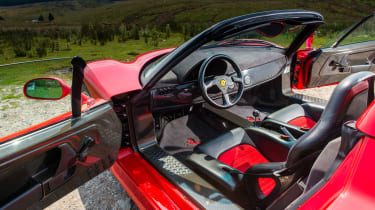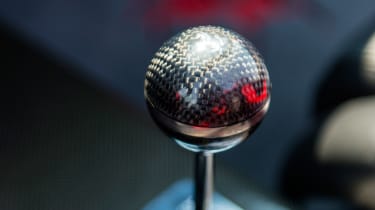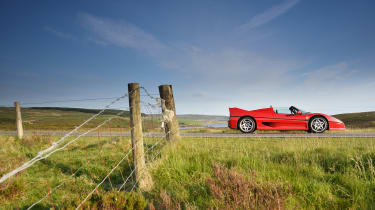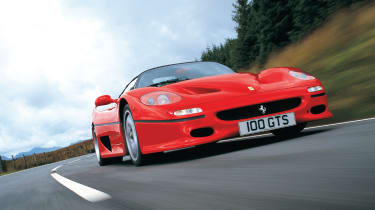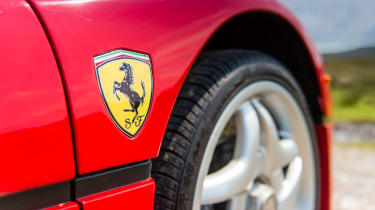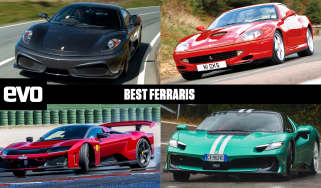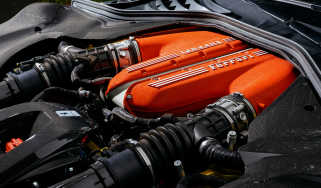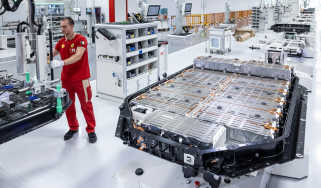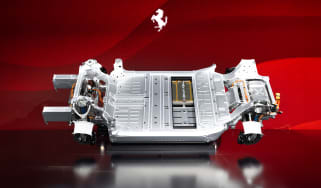Ferrari F50 – review, history, prices and specs
With a Formula 1-derived V12, a manual gearbox and a carbonfibre chassis, the F50 was cutting edge in its day and is now revered as one of the ultimate, if not the most beautiful, supercars ever made
When you have a back catalogue that’s as extensive and delectable as Ferrari’s, choosing between its supercars is an almost impossible task. Daytona? Testarossa? 288 GTO? F40? Enzo? LaFerrari? The list is as long as your arm, and you could make a pretty good case for the vast majority of Maranello’s output over the years being in your Ferrari top ten. But there’s one car that’s consistently overlooked – the glorious F50.
It certainly had some hard acts to follow – the 288 GTO and the F40 – and its successor was the superb Enzo, but the F50 has always struggled to establish its identity in this revered company. Maybe it was its styling that let it down after the beauty of the GTO and the brutal functionality of the F40, or the fact that it wasn’t a fixed-head coupe, it’s removable Targa panel perhaps causing people to think it was somehow more for poseurs than serious drivers?
But they couldn’t be more wrong. Packed full of Formula 1 tech, the F50 was a gloriously balanced supercar, and with a never-to-be-repeated combination of an F1-derived V12 and a gated manual gearbox it was one of the greatest ever analogue supercars. Just 349 were built between 1995 and 1997 and at the time it had a pretty stratospheric price tag – nigh on £350k. Ten years after its launch and in the midst of the financial crisis, F50s changed hands for less than their list price, but today you’ll need over £1.5million to join this rather exclusive club.
Ferrari F50 in detail
Ferrari created the F50 as a 50th anniversary present to itself, even if it was jumping the gun a little bit when the project came to fruition in 1995. But you could forgive this minor mix-up on dates when the F50’s specification was revealed as this was the closest you were likely to get to an F1 car for the road, with an uncompromising, purist approach to the ultimate high-performance road car.
Like all Ferraris, the engine would dominate the experience, and while both the 288 GTO and the F40 had used turbocharged V8s, the F50 was altogether more sophisticated. Its V12 was derived from the engine found in the back of its 1989 F1 car but with a capacity increased to 4.7 litres in the quest for more torque. Peak power was a heady 513bhp, although this was developed at 8500rpm rather than the dizzying 14,000rpm of the F1 car. Torque was perhaps less impressive at 347lb ft at 6500rpm, but the F50 was still good for a 3.7sec 0-62mph time and a top speed just north of 200mph.
It was a glorious engine though and was about as cutting edge as they came in the mid-1990s. Five valves per cylinder, twin overhead camshafts for each bank and dry sump lubrication with Bosch Motronic 2.7 combined ignition and fuel injection ensured it was both tractable and powerful. Perhaps a McLaren F1 would disagree, but it could just be the most glorious naturally aspirated V12 ever fitted to a road car and emitted a sensational howl when extended.
It wasn’t just the engine that utilised tech transfer from the pinnacle of motorsport as the F50 used a carbon-composite construction for its chassis with the carbonfibre passenger cell having the front suspension mounted directly to it, with a tubular substructure projecting forward to support the radiator and ancillary equipment. At the back, the engine was bolted to the rear of the passenger cell and acted as a load-bearing member for the transmission and rear suspension. The differential assembly was mounted to the rear of the engine with the six-speed manual ’box.
Suspension was via wishbones, with a pushrod system for the horizontally mounted spring and damper units, following contemporary F1 principles. An electronic damper control system was incorporated to optimise the ride and handling dependent on road conditions. Brakes were cross-drilled vented discs without servo assistance to provide better feel, while a new style of convex Speedline wheel was fitted – 8.5x18-inch up front and a huge 13x18-inch at the rear.
While the F50 was styled by Pininfarina, it didn’t possess the raw beauty of the machines that had come before it and could almost look rather gawky from some angles. It certainly had plenty of curves and air intake and exits, along with a pretty radical (and aerodynamically important) rear wing, but it was first and foremost styled for efficiency rather than beauty. To keep weight down the body was constructed entirely from composites, and while the removable roof panel allowed the occupants full access to the glorious V12 soundtrack, it wasn’t hugely practical as there was no space to stow the panel within the car.
Inside the light weight ethos continued with a pretty minimalist cabin. There were composite-shelled seats – available in two different widths – and these were trimmed in a combination of leather outer panels and cloth centres. In keeping with the car’s tech-savvy drivetrain and chassis construction Ferrari eschewed the use of traditional instrumentation, moving over to a multicoloured illuminated display within the dash binnacle. And while there were some niceties such as air conditioning, the spartan ethos was continued with wind-up windows.
While the F50 might have struggled a little when new to pique the interest of armchair supercar fans, anyone that was fortunate enough to drive the car more or less instantly fell in love with its tactility and ability, and it’s now fondly looked on as one of the greatest supercars from the analogue era.
Specs
- Engine: 4698cc, V12
- Power: 513bhp @ 8500rpm
- Torque: 347lb ft @ 6500rpm
- Weight: 1230kg
- Power-to-weight: 424bhp/ton
- 0-62mph: 3.7sec (claimed)
- Top speed: 202mph (claimed)
- Price: £342,700 (1996)
What we said
(evo 064)
‘It might sound odd, but in many respects the F50 is a ‘Club Sport’ Enzo – a purer, even more focused version stripped of all aids including power steering, brake servo, anti-lock and traction control. A version that has been honed to connect with the driver and put the driver in control, not least through a manual gearbox of outstanding quality which somehow makes the power of its V12 seem more real. You don’t simply jump into the F50 and go fast. You have to work at it, take more notice of the feedback and get it to flow, but the satisfaction of driving it well is immense. Today, Ferrari probably wouldn’t countenance the levels of vibration and harshness induced by the 60-valve V12, but it’s all a part of the unique experience the F50 delivers.’
John Barker
‘The Enzo is more sophisticated and arguably a greater achievement, but Ferrari perfected what we think of as a supercar when it made the F50. It’s the most engaging physically and emotionally, which is why it’s the best supercar Ferrari has made.’
Jethro Bovingdon

